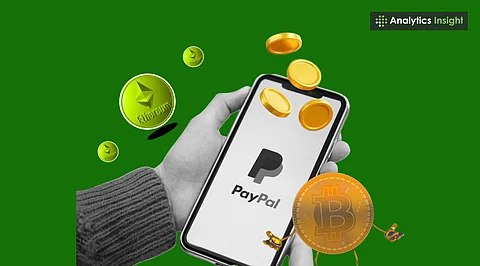

PayPal’s Pay with Crypto lets users pay with Bitcoin, Ethereum, and Tether while merchants receive instant USD.
Lower fees and faster settlements make global payments easier for businesses and customers.
This feature positions PayPal as a leader in crypto-powered digital payments.
PayPal has launched a new feature called Pay with Crypto. This allows people in the United States to pay for goods and services using over 100 different cryptocurrencies, such as Bitcoin (BTC), Ethereum (ETH), Tether (USDT), USD Coin (USDC), Solana (SOL), and Binance Coin (BNB).
Customers can use popular wallets like Coinbase, MetaMask, Binance, and Kraken to complete the payment. When a customer pays with crypto, PayPal instantly converts the cryptocurrency into US dollars or PayPal’s stablecoin, PYUSD.
One of the biggest attractions is the low fee. PayPal charges 0.99% per transaction, which is much cheaper than traditional credit card fees that can go as high as 3.5%. For businesses, especially small ones, this can save a lot of money on international transactions.
The crypto market is now worth over $3 trillion worldwide, and more than 650 million people own some form of cryptocurrency. Until now, most of that cryptocurrency has been mainly for investing or trading. It wasn’t widely used for everyday payments.
PayPal’s Pay with Crypto could change that through:
Sending money across countries is usually expensive and slow.
Pay with Crypto makes payments faster and cheaper because it does not need banks or multiple intermediaries.
A payment can be completed almost instantly, and the merchant gets paid in dollars.
Many businesses avoided crypto because of price volatility.
With PayPal’s system, they never hold the crypto directly.
They only see US dollars or PYUSD in their accounts, making the process safe and simple.
Stablecoins are digital currencies tied to a real-world currency like the USdollar.
PayPal’s PYUSD is a stablecoin fully backed by US dollar reserves.
Merchants can even earn rewards of around 4% per year if they keep PYUSD in their PayPal account.
PayPal is connecting to wallets around the world through a project called PayPal World.
This means that in the future, a merchant in the US could easily receive payments from a customer in India, Brazil, or Africa.
Also Read: Bitcoin vs. MicroStrategy: What’s the Smarter Choice?
The feature could disrupt the old payment system in several ways:
Lower fees mean more profit for merchants: Businesses that sell online or internationally will save money on transaction costs.
Faster settlement: Instead of waiting days for cross-border payments, transactions can settle in seconds or minutes.
Reduced reliance on traditional card networks: If merchants start using PayPal Crypto for most payments, companies like Visa and Mastercard may see more competition.
Boost to financial inclusion: In many countries, people have smartphones but no bank accounts. Using cryptocurrency wallets connected to PayPal gives them access to global payments.
This new service is not just about technology; it is big business for PayPal.
Stronger earnings: PayPal recently reported a 23% growth in profit year over year. Offering cryptocurrency services like this could bring in new revenue and reduce costs.
Promoting PYUSD: PayPal wants more people to use its stablecoin, PYUSD. If PYUSD becomes widely used for payments, PayPal can control a bigger part of the digital payment market.
Building a global payments ecosystem: PayPal is positioning itself as a bridge between traditional finance and the growing cryptocurrency world.
Even though Pay with Crypto is promising, it comes with challenges:
Some US states and countries are still cautious about these payments.
PayPal cannot fully expand until all regulators approve the service.
Other companies like Mastercard, Stripe, and banks are also entering the stablecoin and blockchain space.
PayPal will need to move fast to keep its lead.
Some European officials worry that US dollar-backed stablecoins like PYUSD could reduce the role of local currencies.
This could lead to stricter rules in some regions.
Pay with Crypto could change how the world pays online. Here’s what the future might look like:
Digital currencies and stablecoins will become common for everyday purchases.
Small businesses will sell internationally with lower fees.
Traditional card payments may become less popular for online transactions.
Global wallets will make payments possible from any country to any country.
This shift is also part of a bigger movement called tokenized finance, a world where money and assets move instantly on blockchains instead of through slow, expensive bank networks.
Also Read: How Ethereum Became a Leading Cryptocurrency
PayPal’s Pay with Crypto is more than a new payment feature. It is a major step toward a cheaper, faster, and more global payment system.
Merchants will enjoy lower fees and instant settlements.
Customers will finally be able to spend their crypto easily.
PayPal strengthens its position as a leader in digital and blockchain payments.
If adoption continues, this could mark the beginning of a new era in the payment industry. One where crypto, stablecoins, and digital wallets work together to make money move as easily as sending a message.
